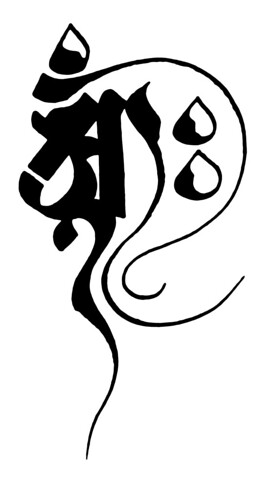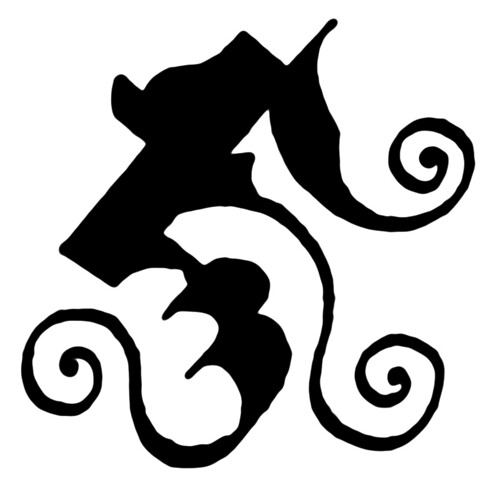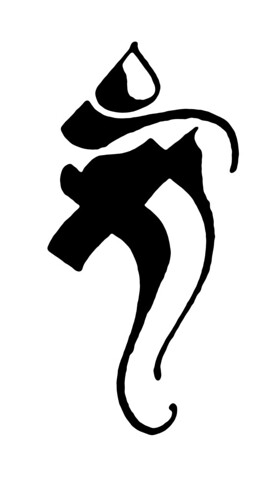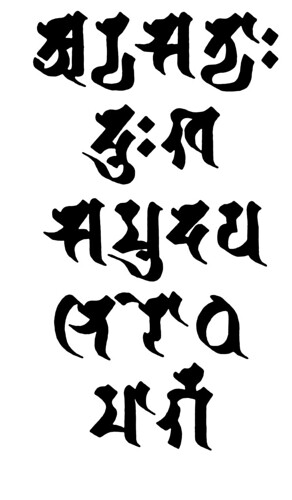25 April 2011
Book Progress
24 April 2011
āṃḥ - decorative Siddhaṃ script
This syllable āṃḥ contains many symbols - vision and transformation, śūnyatā, nirvāṇa, triratna etc. And it has great calligraphic potential as you see. It's made from four syllables: a ā aṃ aḥ so also is a 5-fold maṇḍala. Everything is here.
21 April 2011
Arapacana - translation
 I've finished my translation of the Arapacana in the Sanskrit edition of the Pañcaviṃśatisāhasrikā Prajñāpāramitā Sūtra (PPS), or The Discourse on Perfect Wisdom in 25,000 lines, produced by Takayasu Kimura (1986-2009).
I've finished my translation of the Arapacana in the Sanskrit edition of the Pañcaviṃśatisāhasrikā Prajñāpāramitā Sūtra (PPS), or The Discourse on Perfect Wisdom in 25,000 lines, produced by Takayasu Kimura (1986-2009).In creating this translation I have also consulted the Sanskrit edition by Dutt (1934); the Chinese translations by Kumārajīva (T. 223) and Xuán Zàng (T. 220 - incorporating PP versions in 18k, 25k, and 100k lines) as found in CBETA online version of the Taisho Ed. of the Chinese Tripiṭaka ; and Edward Conze’s English translation (1975), particularly his notes on translation and ms. variants. Conze cites Mokshala [sic] which I take to be a reference to T. 221, the translation of the PPS by Mokṣa (or Mokṣala); and Yüan-tsang [sic; i.e. Xuán Zàng] which I take to be a reference to T.220.
I have also used Brough’s (1977) discussion of the Arapacana in 普曜經 (Pǔ yào jīng = The Lalitavistara Sūtra; T. 186), translated by Dharmarakṣa in 308 CE, to shed light on Chinese translations. Brough himself also refers to Kumārajīva’s translation of the Mahāprajñāpāramitopadeśa (T. 1509 ) a commentary on the PPS attributed to Nāgārjuna which appears not to coincide with T. 223 in every detail; and Xuán Zàng’s various translations of the large Perfection of Wisdom text contained within T. 220.
In addition there is a very old Arapacana Alphabet in the Bajaur Collection which is mostly unpublished and I have consulted it where possible. Salomon (1990) is invaluable for understanding the alphabet in any script or language. The Sanskrit editions, and presumably the Sanskrit mss. contain several conflicts that are resolved by Conze – and in each case I have followed his example, but only after consulting some of the same sources (particularly the Chinese texts) and the secondary literature. The last few lines are very confused and show a great deal of variation in both the syllable and the keyword, not to mention the fact that the number of syllables varies from 41 – 43, while the text itself later refers to 42 letters ‘dvācatvāriṃśad akṣarāṇi’.
Download a pdf of my Arapacana Translation
Please contact with any comments on this work. My thanks to readers of my VM Facebook page for contributing to Chinese translations.
17 April 2011
jñā - decorative
"know, knowledge" root of many important Buddhist technical terms: jñāna, prajñā, saṃjñā, vijñāna, sarvajñā.
16 April 2011
15 April 2011
13 April 2011
Arapacana Alphabet in the Pañcaviṃśatisāhasrikā prajñāpāramitā in Sanskrit and Chinese
There's quite broad agreement up to about letter 26. Note that Conze also uses the Chinese translation by Mokṣa of Khotan (Taisho 221), but so far I haven't identified the arapacana alphabet in this text. All the lists except Conze include repetitions. Conze's solutions to this problem look likely and involve Prakrit spellings of Sanksrit words, i.e. ṣaṃga for saṅga at no.10. (Note that the Chinese transliterations support this sustitution by using an aspirated sibilant sound.) The number of syllables in the various alphabets various from 41-43 (Dutt has 44!) but we know that later in the Pañcaviṃśati the text is expecting 42 (dvācatvāriṃśad akṣarāṇi PSP_6-8:67-8).
| Conze | Takayasu | Kumārajīva | Xuán Zàng | |||||
| 1 | a | a | 阿 | Ā | [褒-保+可] | [Bāo-bǎo +kě] | ||
| 2 | ra | ra | 羅 | Luó | 洛 | Luò | ||
| 3 | pa | pa | 波 | Bō | 跛 | Bǒ | ||
| 4 | ca | ca | 遮 | Zhē | 者 | Zhě | ||
| 5 | na | na | 那 | Nà | 娜 | Nuó | ||
| 6 | la | la | 邏 | Luó | 砢 | Luǒ | ||
| 7 | da | da | 陀 | Tuó | 柁 | Duò | ||
| 8 | ba | ba | 婆 | Pó | 婆 | Pó | ||
| 9 | ḍa | ḍa | 荼 | Tú | 荼 | Tú | ||
| 10 | ṣa | sa | 沙 | Shā | 沙 | Shā | ||
| 11 | va | va | 和 | Hé | 縛 | Fù | ||
| 12 | ta | ta | 多 | Duō | [多*頁] | [Duō*yè] | ||
| 13 | ya | ya | 夜 | Yè | 也 | Yě | ||
| 14 | ṣṭa | sta | 咤 | zhà | 瑟吒 | (Sè zhà) | ||
| 15 | ka | ka | 迦 | Jiā | 迦 | Jiā | ||
| 16 | sa | sa | 娑 | Suō | 娑 | Suō | ||
| 17 | ma | ma | 磨 | Mó | 磨 | Mó | ||
| 18 | ga | ga | 伽 | Jiā | 伽 | Jiā | ||
| 19 | stha | stha | 他 | Tā | 他 | Tā | ||
| 20 | ja | ja | 闍 | Dū | 闍 | Dū | ||
| 21 | śva | śva | 簸 | bǒ | 濕縛 | (Shī fù) | ||
| 22 | dha | dha | 馱 | Tuó | 達 | Dá | ||
| 23 | śa | śa | 賒 | Shē | 捨 | Shě | ||
| 24 | kha | kha | 呿 | Qū | 佉 | Qū | ||
| 25 | kṣa | kṣa | 叉 | Cha | 羼 | Chàn | ||
| 26 | sta | sta | 哆 | Duō | 薩[多*頁] | (Sà [duō*yè]) | ||
| 27 | jña | jña | 若 | Ruò | 若 | Ruò | ||
| 28 | rta | ha | 拖 | Tuō | 剌他 | (Là tā) | ||
| 29 | ha | ccha | 婆 | Pó | 呵 | Ā | ||
| 30 | bha | sma | 車 | Chē | 薄 | Báo | ||
| 31 | ccha | hva | 摩 | Mó | 綽 | Chuò | ||
| 32 | sma | sa | 火 | Huǒ | 颯磨 | (Sà mó) | ||
| 33 | hva | gha | 嗟 | Jiē | 嗑縛 | (Kè fù) | ||
| 34 | tsa | ṭha | 伽 | Jiā | 蹉 | Cuō | ||
| 35 | gha | ṇa | 他 | Tā | 鍵 | Jiàn | ||
| 36 | ṭha | pha | 拏 | Ná | 搋 | Chǐ | ||
| 37 | ṇa | ska | 頗 | Pō | 拏 | Ná | ||
| 38 | pha | ja | 歌 | Gē | 頗 | Pō | ||
| 39 | ska | ca | 醝 | Cuó | 塞迦 | (Sāi jiā) | ||
| 40 | ysa | ṭa | 遮 | Zhē | 逸娑 | (Yì suō) | ||
| 41 | śca | ḍa | 咤 | zhà | 酌 | Zhuó | ||
| 42 | ṭa | 荼 | Tú | 吒 | Zhà | |||
| 43 | ḍha | 擇 | Zé | |||||
12 April 2011
Chinese Arapacana Alphabet
阿 羅 波 遮 那 邏 陀 婆 荼 沙 和 多 夜 [口*宅] 迦 娑 磨 伽 他 闍 [其*皮] 馱 賒 呿 叉 哆 若 拖 婆 車 摩 火 嗟 伽 他 拏 頗 歌 醝 遮 [口*宅] 荼Google offers the following transliterations:
Ā luó bō zhē nà luó tuó pó tú shā hé duō yè [kǒu*zhái] jiā suō mó jiā tā dū [qí*pí] tuó shē qū cha duō ruò tuō pó chē mó huǒ jiē jiā tā ná pō gē cuó zhē [kǒu *Zhái] tú.I'm looking at the Sanskrit version and got interested enough to track this down. This version has 42 syllables which fits the number mentioned in the text. Conze's translation has 43 letters, and the two Sanskrit editions online at the Gretil Archive (Dutt and Takayasu) both have 41.
Ideally I'd like to get more info about the fragment from the Bajaur collection to compare the versions. We know it has 42 letters and what a few of the key words are, but the conservators of the collection are occupied with other texts at present (and have been for some years now!)
BTW The reason I'm looking at this is because I am doing my own translation for the book. I could use Conze's but it is covered by copyright and I'm trying to minimize the amount of copyright material in the book (hopefully I'll eliminate it altogether because applying for permission is slow and time consuming, and potentially expensive!). But as I go I find I am not at all satisfied with Conze's translations any way - at times I am none the wiser about what the Sanskrit means for having read his translation. Unlike translating Pāli texts in which one can usually see quite easily what is meant, the Perfection of Wisdom texts are esoteric in the sense of requiring a commentary that I lack access to if it exists!
10 April 2011
09 April 2011
akāro mukhaḥ sarvadharmāṇāmādyanutpannavāt
अकारो मुखः सर्वधर्माणामाद्यनुत्पन्नत्वात्
Sanskrit translates as: "The letter 'a' is an opening because of the primal quality of non-arising of all mental phenomena." [my translation]
First line of the Arapacana acrostic as found in the Pañcaviṃśatisāhasrikā Prajñāpāramita Sūtra (The Perfection of Wisdom Sūtra in 25,000 lines). More info on the Visible Mantra Arapacana page.
Each line of this acrostic has a key word which begins with the the corresponding letter of the Gāndhārī alphabet (as envisaged by Sanskrit speakers). The whole collection make up a meditation practice in which the practitioner tries to see the true nature of experience as empty of independent existence - i.e. that all experiences are conditioned by the meeting of mind and mental objects.
(Thanks again to Dksht for spotting errors. I think both the Siddhaṃ and Roman are correct now)
08 April 2011
Arapacana Alphabet in the Pañcaviṃśatisāhasrikā prajñāpāramitā
akāro mukhaḥ sarvadharmāṇām ādyanutpannatvāt,
repho mukhaḥ sarvadharmāṇāṃ rajo 'pagatatvāt,
pakāro mukhaḥ sarvadharmāṇāṃ paramārthanirdeśāt,
cakāro mukhaḥ sarvadharmāṇāṃ cyavanopapattyanupalabdhitvāt,
nakāro mukhaḥ sarvadharmāṇāṃ nāmāpagatatvāt,
lakāro mukhaḥ sarvadharmāṇāṃ lokottīrṇatvāt, tṛṣṇālatāhetupratyayasamudghātitvāt,
dakāro mukhaḥ sarvadharmāṇāṃ dāntadamathaparicchinnatvāt,
(PvsP1-2: 86)
bakāro mukhaḥ sarvadharmāṇāṃ bandhanavimuktatvāt,
ḍakāro mukhaḥ sarvadharmāṇāṃ ḍamarāpagatvāt,
sakāro mukhaḥ sarvadharmāṇāṃ saṃgānupalabdhitvāt,
vakāro mukhaḥ sarvadharmāṇāṃ vākpathaghoṣasamucchinnatvāt,
takāro mukhaḥ sarvadharmāṇāṃ tathatācalitatvāt,
yakāro mukhaḥ sarvadharmāṇāṃ yathāvadanutpādatvāt,
stakāro mukhaḥ sarvadharmāṇāṃ stambhānupalabdhitvāt,
kakāro mukhaḥ sarvadharmāṇāṃ kārakānupalabdhitvāt,
sakāro mukhaḥ sarvadharmāṇāṃ samatānupalabdhitvāt,
makāro mukhaḥ sarvadharmāṇāṃ mamakārānupalabdhitvāt,
gakāro mukhaḥ sarvadharmāṇāṃ gaganānupalabdhitaḥ,
sthakāro mukhaḥ sarvadharmāṇāṃ sthānānupalabdhitaḥ,
jakāro mukhaḥ sarvadharmāṇāṃ jātyanupalabdhitaḥ,
śvakāro mukhaḥ sarvadharmāṇāṃ śvāsānupalabdhitaḥ,
dhakāro mukhaḥ sarvadharmāṇāṃ dharmadhātvanupalabdhitaḥ,
śakāro mukhaḥ sarvadharmāṇāṃ śamathānupalabdhitaḥ,
khakāro mukhaḥ sarvadharmāṇāṃ khasamatānupalabdhitaḥ,
kṣakāro mukhaḥ sarvadharmāṇāṃ kṣayānupalabdhitaḥ,
stakāramukhāḥ sarvadharmās tac cānupalabdhitaḥ,
jñakāramukhāḥ sarvadharmāḥ sarvajñānānupalabdhitaḥ,
hakāramukhāḥ sarvadharmāḥ hetor anupalabdhitaḥ,
cchakāramukhāḥ sarvadharmāś cchaver apy anupalabdhitaḥ,
smakāramukhāḥ sarvadharmāḥ smaraṇānupalabdhitaḥ,
hvakāramukhāḥ sarvadharmā āhvānāpagatatvāt,
sakāramukhāḥ sarvadharmā utsāhānupalabdhitaḥ,
ghakāramukhāḥ sarvadharmā ghanānupalabdhitaḥ,
ṭhakāramukhāḥ sarvadharmā viṭhapanānupalabdhitaḥ,
ṇakāramukhāḥ sarvadharmā raṇavigatatvāt,
phakāramukhāḥ sarvadharmāḥ phalānupalabhitaḥ,
skakāramukhāḥ sarvadharmāḥ skandhānupalabdhitaḥ,
jakāramukhāḥ sarvadharmā jarānupalabdhitaḥ,
cakāramukhāḥ sarvadharmāś caraṇānupalabdhitaḥ,
ṭakāramukhāḥ sarvadharmāḥ ṣṭaṃkārānupalabdhitaḥ,
(PvsP1-2: 87)
ḍhakāramukhāḥ sarvadharmā ḍhaṃkārānupalabdhitaḥ.
07 April 2011
Sacred Calligraphy of the East
 I noted earlier today that Sacred Calligraphy of the East appeared to be out of print, and is suffering a massive inflation of prices. I wrote to Shambala Publication, and I've heard back from them:
I noted earlier today that Sacred Calligraphy of the East appeared to be out of print, and is suffering a massive inflation of prices. I wrote to Shambala Publication, and I've heard back from them:Unfortunately, Sacred Calligraphy of the East is out of print. Our last printing of this title was in 2002 and there is no planned future reprinting. Once books go out of print, they are harder to find and the prices to buy them does go up quite a bit. [sic]Only demand is likely to result in the book being reprinted. Please consider writing to Shambala Publications (customercare@shambhala.com) to ask them to reprint the book. Meanwhile I will investigate the possibility of producing my own edition of the book. I suspect it might be more than I can afford, but hopefully we can work something out.
Siddhāṃ vs Siddhaṃ
I think we should be clear that these forms are just wrong, and that a mistake repeated for 1000 years is wrong on a much larger scale. Everything that is faulty with religion is summed up in this idea that we should simply accept something we know to be erroneous because 'that's how we've always done it'. The whole point of retaining the Siddhaṃ script in East Asia was in order to preserve the Sanskrit pronunciation. As Kūkai himself says:
"The mantras, however, are mysterious and each word is profound in meaning. When they are transliterated into Chinese, the original meanings are modified and the long and short vowels are confused. In the end we can get roughly similar sounds but not precisely the same ones. Unless we use Sanskrit, it is hardly possible to differentiate the long and short sounds. The purpose of retaining the source materials, indeed, lies here." - Kūkai. Shōrai mokuroku. Hakeda. Kūkai: Major Works, p.144.What's more these are elementary mistakes, one's that even with a little Sanskrit anyone can see. So, let's correct them.
Siddhāṃ is wrong because siddhaṃ is a neuter word and the form should be siddhaṃ with a short a. This is precisely the kind of problem with long and short vowels that Kūkai had in mind I think!
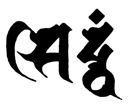
siddhaṃ
Siddhāṃrastu is wrong again because of the long ā, but in addition because there is no word 'rastu'. Judging from the translation 'may there be perfection' we can guess that what is intended is the word astu. This is the 3rd personal singular imperative of the verb √as 'to be' and means 'may it be'. Where the ra comes from is a mystery, and it renders the phrase meaningless. The correct form (with sandhi) is siddhamastu.
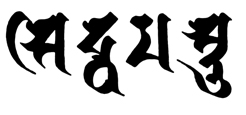
siddhamastu
Namaḥ sarvajñāya siddhāṃ presents more of a challenge. Steven's translation is 'homage to the all-knowing perfection'. Here sarvajñāya represents a kind of false Sanskrit - it uses the idea that if you just add -ya onto a word it makes it into the dative case indicating 'to' or 'for'. We find this in the homage 'namo buddhāya' for instance, which works OK because Buddha is a masculine noun in -a. But jñā is a feminine noun in -ā, and the dative would be jñāyai. This form is found in the homage to the perfection of wisdom for example: oṃ namo bhagavatyai prajñāpāramatāyai. But in a sense this is beside the point because the word is clearly intended to from a compound with siddhaṃ. 'The all-knowing perfection' would be sarvajñāsiddha - taking it as a karmadhāraya compound. In this case the first element loses it's case endings and only the second element is declined. In this the dative form would be: sarvajñāsiddhāya. So the correct form of this would namaḥ sarvajñāsiddhāya. There is an option sandhi here which would affect the final visarga in namaḥ giving namassarvajñāsiddhāya.

namaḥ sarvajñāsiddhāya
I note btw that Sacred Calligraphy seems to be out-of-print. It is selling on Amazon UK for £30 second-hand and up to £150 new! The RRP is US$32.50 on my copy (about £20). This is outrageous and I can only hope that Shambala Publishing opt to reprint soon!
05 April 2011
ārya-satya - The Noble Truths
Some calligraphy for the book - getting towards the end of the English proof reading and fixing images now. I think you will agree that this is much better work than what's on the website currently. The four noble truths are one of the most succinct summaries of the Buddhist teachings.
duḥkha - disappointment
samudaya - cause (of disappointment)
nirodha - cessation (of disappointment)
mārga - road (to the cessation of disappointment)
K.R. Norman has pointed out that, despite the received tradition, a more likely translation is 'truths of the noble ones' which is supported by the Pāli commentaries.
04 April 2011
Calligraphy Workshop in London
 A special opportunity is coming up if you are interested in Tibetan calligraphy.
A special opportunity is coming up if you are interested in Tibetan calligraphy.The Shang Shung London Institute of Tibetan Studies presents a weekend workshop of Tibetan calligraphy, lead by Tashi Mannox on 25-26th June 2011.
Tashi is an expert calligrapher with a lifetime of study and practice.
03 April 2011
Siddhaṃ Seed Syllables - ha hāṃ hoḥ hrīḥ hūṃ
Variations on the Saṃskrita akṣara ha.
ha - Kṣitigarbha - Jizō (地蔵).
hāṃ - Acala Vidyārāja - Fudō Myōō (不動明王)
hoḥ - jaḥ hūṃ vaṃ hoḥ!
hrīḥ - padma family especially Amitābha
hūṃ - vajra family especially Akṣobhya

